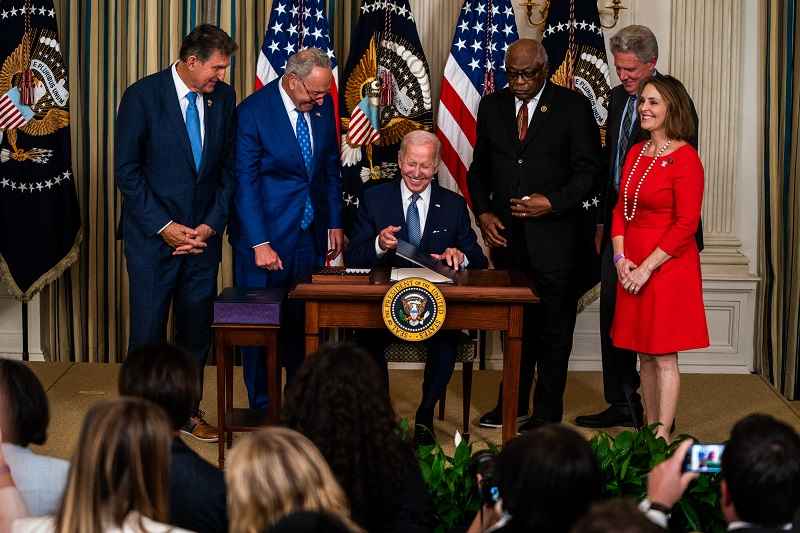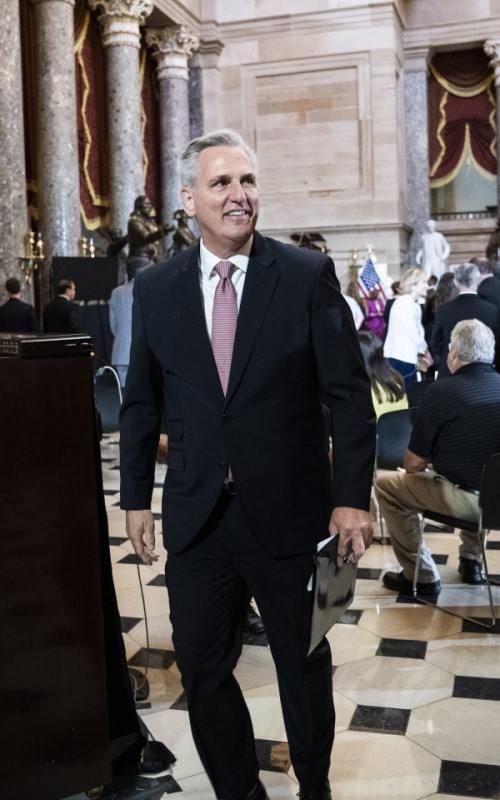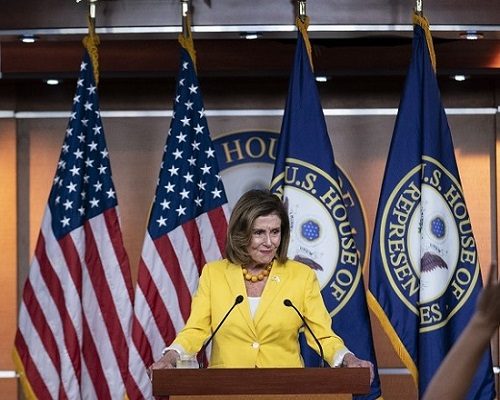Once unthinkable, Democrats now see narrow path to keeping the House

President Joe Biden signs the Inflation Reduction Act of 2022 into law at the White House on Aug. 16, 2022. From left, Sen. Joe Manchin, D-W.Va; Senate Majority Leader Chuck Schumer, D-N.Y.; House Majority Whip Rep. James Clyburn, D-S.C.; and Reps. Frank Pallone, D-N.J., and Kathy Castor, D-Fla.
15:45 JST, August 28, 2022
Democrats are voicing growing confidence about limiting losses in the House and potentially even salvaging their majority in the midterm elections, with candidates and allied groups making moves to capitalize on a backlash to abortion restrictions, signs of improvements in the economy and opposition to Donald Trump.
After months of gloomy predictions, Democrats are investing anew in flipping Republican seats. They are also directing more money to protect a roster of their own endangered incumbents – a list party officials said noticeably shrank since the spring. And they are trying to frame contests around abortion rights, putting Republicans on the defensive for strict opposition to the procedure in the wake of the Supreme Court overturning Roe v. Wade.

Democratic lawmakers take part of a demonstration at an abortion rights rally, less than one month after the Supreme Court issued a ruling that reversed Roe v. Wade., on Capitol Hill on July 19, 2022 in Washington.
Democratic fundraisers have reported an uptick in donations over the last month, and at least one of the party’s biggest donors is considering pouring more money into House races, according to people with knowledge of the situation.
Speaker Nancy Pelosi, D-Calif., is privately voicing more confidence about the House landscape and opportunities to go on offense, people familiar with the conversations said, while President Joe Biden’s White House has grown more optimistic in its outlook. One Biden adviser reacted with umbrage at a private meeting with reporters this month to the suggestion that Republicans were likely to win back control of Congress.
While Democrats acknowledge they still face major hurdles, there has been an unmistakable mood shift, according to interviews with candidates, strategists and officials. What was once a party privately bracing for dozens of losses is now one reassessing the House landscape and shifting to a more offensive posture with about 10 weeks left before Election Day.
“I definitely feel a different energy than even three months ago, but certainly six months ago,” said Rep. Elissa Slotkin, D-Mich., one of the year’s most vulnerable incumbents. Seeing a “narrow” path to keeping the majority, Slotkin added: “Six months ago I think people were putting safe bets on a real blowout. And I don’t see that happening.”
One House Democratic strategist, who like others interviewed for this story spoke on the condition of anonymity in order to speak candidly, was blunter in assessing what it would take to win the 218 seats required to control the House, in a chamber of 435 members. “The range has shifted. The world we were living in before, if we ended up in the 200s that was pretty good,” said the strategist. “Now it is much more that the majority is in play. We have a path. It is there.”
Democrats are defending only a five-seat majority in the House, putting Republicans well within reach of winning back control. Nonpartisan analysts still regard the GOP as the favorites and history shows the president’s party does not tend to do well in a first midterm. Republican strategists pointed to continued opportunities to make gains where Democrats are on defense and questioned whether recent indicators portend much for the fall, particularly if prices rise again on Democrats’ watch.
“Every great team experiences some adversity,” Rep. Tom Emmer, Minn., the chair of the National Republican Congressional Committee, wrote in a memo after a special election loss this past week in New York’s 19th Congressional District. Trying to calm Republican nerves, much as Democrats had been doing last year, he added: “This will only make us stronger heading into Election Day.”

House Minority Leader Kevin McCarthy (R-Calif.), departs after a dedication and unveiling ceremony of a statue in honor of Amelia Earhart, in Statuary Hall on Capitol Hill in July 2022.
Yet several Republican strategists have expressed concern about winning the House with only single-digit margins, which would make it harder for Minority Leader Kevin McCarthy, R-Calif., to easily ascend to speaker and could complicate the party’s ability to rally for even routine partisan votes. Those same strategists had hoped earlier this year to win a margin of 20 or more on the backs of a soured national mood and rising inflation.
In the battle for the Senate, Democrats started seeing signs of encouragement earlier this summer, due to unsteady Republican candidates and other factors that are also starting to show up in House races, party strategists said. Abortion has been a major driver of the improved Democratic outlook, they noted, with the Supreme Court decision in June to strike down the constitutional right to abortion as a key inflection point that angered many voters.
In four special elections for House seats since that decision – including in New York’s 19th District, where the party’s candidate centered his campaign on abortion – Democrats outperformed Biden’s 2020 showing. The resounding defeat of an antiabortion ballot measure in conservative Kansas was more evidence of the galvanizing effect of the court’s decision and subsequent attempts to curtail abortion rights, especially in states where the laws are in limbo. Democrats in recent days have launched ads in several battleground House races attacking Republicans for embracing strict antiabortion stances.

Democratic candidate Pat Ryan, center, receives acknowledgement during a rally in Kingston, New York, on Aug. 13, 2022.
“Showing a fighting spirit is absolutely critical,” said Democrat Pat Ryan, who was victorious in the New York’s 19th District after running heavily on abortion. “A lot of people rallied around just strong, clear, unequivocal positions on issues that in the past, a lot of people would say ‘You should be much more delicate or nuanced.'”
Ryan’s victory came in a district Biden won by under two percentage points – giving Democrats hope of performing well in the 222 seats where Biden did better, party strategists said. But analysts have noted that the recent special elections, including Ryan’s, saw high turnout in hubs for college-educated voters. Ryan tempered the outlook for others. “I don’t know if it’s replicable,” he said of his win.
Beyond abortion, Democratic strategists said they have found the reduction of gas prices and the slowing of inflation as helpful to their chances. Democratic strategists said they have come to feel, for the moment, that they can fight Republicans to something of a draw on the economy, in part because Republicans have not put forward any clear policy alternatives.
Party leaders have sought to channel these developments – along with recent legislative accomplishments on health-care and climate change as well as the high-profile House committee hearings about the Jan. 6, 2021, attack on the U.S. Capitol by a pro-Trump mob – into a simple argument they are putting before voters: Republicans are extreme and Democrats have delivered.
They are betting that such a platform will break through, particularly in the suburban battleground areas where the fight for control of the House is expected to heavily run through this fall. Such places swung sharply toward Democrats during Trump’s presidency but are seen as ripe targets for Republicans amid economic malaise and dissatisfaction with Biden.
Democrats’ newfound confidence about the overall map is evident in some of the recent spending decisions the party has made.
House Majority PAC, an outside group charged with helping Democrats hold on to the chamber, is investing in three GOP-held seats, according to data from the commercial tracking company AdImpact. The new buys are intended to boost Democratic challengers in California’s 22nd Congressional District, Ohio’s 1st Congressional District and New Mexico’s 2nd Congressional District. All are Republican-held seats where Biden won in 2020.
The House Democratic strategist who said the majority was in play said the shifts in the national mood had not yet resulted in expanding the Democratic battlefield. But they had reduced concern about some safer incumbents who appeared vulnerable at the beginning of the summer, allowing for more resources to be devoted to borderline seats.
A Democrat familiar with the Democratic Congressional Campaign Committee’s strategy, who spoke on the condition of anonymity to share internal deliberations, listed several Democratic lawmakers in the DCCC’s “Frontline” incumbent protection program who no longer worry party leadership. They include Democratic Reps. Chrissy Houlahan, Pa.; Bill Foster, Ill; Mikie Sherrill, N.J.; Jennifer Wexton, Va.; and Kathy Manning, N.C., according to this person. Biden won handily in each district, taking between 55-58 percent of the vote there.
“With 80 days to go, we like very much the way this is going,” said Sean Patrick Maloney, D-N.Y., chair of the DCCC, in an interview. Reinforcing the limits of Democrats’ outlook, Maloney, when pressed, specified that he feels better now about “a certain layer of seats that wouldn’t normally trouble us.”
Republicans still feel like they are on offense, putting pressure on Democrats, said Republican strategist Matt Gorman. He cautioned against overreading special election results. “It’s almost like the scene from ‘I Love Lucy’ with the chocolates coming down the conveyor belt: You can eat one, but you can’t eat all of them at the same time,” Gorman said. “So Democrats can tweak one but you can’t do that in 25 races.”
Following a string of Democratic retirements and the decennial redistricting process, Republicans were left with an open path to the majority, which GOP officials said still exists – even if it doesn’t extend as deeply into Democratic turf as many hoped. The NRCC recently circulated a list of 74 seats they’ve targeted, including nine pickup opportunities in districts that Trump won by more than five points. Democrats are also eying several pickup opportunities in districts Biden won comfortably.
On Friday, the DCCC independent expenditure arm announced another $24 million in new reservations for ad buys. Some of the new reservations are to bolster the party’s efforts to go on offense, including about $1.2 million to help Democrats take a GOP held seat in California and about $1.6 million to help the party flip a GOP-held seat in Michigan. But most of the new money is aimed at defending seats that Democrats already hold.
“If they’re feeling so confident, why are they spending millions of dollars to defend seats deep in Democratic territory,” said NRCC communications director Michael McAdams.
A new round of Democratic outside money will also fund TV ads in a Pennsylvania for the seat held by Rep. Matthew Cartwright, D, according to the AdImpact data, helping to shore up one of the most vulnerable members of the House. Biden is set to appear in coming days with Cartwright.
Cartwright, whose district was won by Trump in 2020, explained the presidential visit as a measure of loyalty more than anything else. “I’ve been friends with Joe Biden for thirty years, what kind of person distances themselves from their friends just because their friends are a few points down in the polls? What kind of person does that? Nobody I want to know,” Cartwright said in an interview.
In an encouraging sign for Cartwright and other Democrats, Biden’s job approval ratings, while still negative, have shown signs of improvement. A recent Gallup poll showed it ticking up six points from July to August, rising from 38 percent to 44 percent, boosted by gains among independents.
When asked whether the electoral landscape has improved for House Democrats, Cartwright sounded notes of caution. “Well it seems like it,” Cartwright said. “But how often have we been burned by the pollsters?”
At the White House and in Biden’s inner circle, top aides have become more bullish about the House. “Look, the generic data on the House side is in our favor right now,” a Biden adviser said at an Aug. 11 meeting with reporters. “I can tell you, this thing is very competitive across the country. You guys have not caught up to this yet.”
But there have been tensions between the White House and House Democratic leaders. Recently, Pelosi confronted Biden at a signing ceremony for legislation to help veterans exposed to toxic burn pits, according to two people familiar with the situation, to express disappointment that House members didn’t receive recognition she felt they deserved. Biden only briefly mentioned the bill’s main sponsor, Rep. Mark Takano, D-Calif., chairman of the House Veterans’ Affairs Committee.
When asked for comment, Pelosi’s deputy chief of staff Drew Hammill said: “This is a silly leak. The Speaker is well known for her advocacy for House Democrats’ role in passing legislation. Obviously, the Speaker wanted the main author, Chairman Takano, and therefore the House, appropriately recognized.”
Separately, Pelosi complained that the White House scheduled a ceremony to celebrate the enactment of the Inflation Reduction Act on a day that the House is scheduled to be in recess, making it difficult for Democratic members to share credit for the landmark climate and health-care law that many of them hope to campaign on in the fall, according to the two people familiar with the situation. The White House heeded Pelosi’s concerns, and moved the event to accommodate the House schedule.
Officials familiar with the disputes between Biden and Pelosi downplayed them as scheduling snags and standard efforts to get members recognized. But the friction underlines a larger and long-standing concern among some House Democrats that Biden and his staff are far more focused on the Senate, where Biden served for decades.

House Speaker Nancy Pelosi (D-Calif.) delivers her weekly news conference at the U.S. Capitol in Washington on Aug. 12, 2022.
“It’s routine to have scheduling discussions like this with either chamber any time a major piece of our shared agenda passes,” said White House spokesman Andrew Bates.
Democratic fundraisers have also reported more interest in the House, as deep pocketed donors, enthused by issues like guns, abortion and the threats to democracy, see Congress as being once again on the table after a brutal winter and fall.
“There is a big difference between having a zero chance of success and a 30 percent chance of success,” said Steve Elmendorf, a Democratic lobbyist who previously worked in House leadership staff. “And if we do the right things over the next month, and go out and sell the accomplishments of the last year, we could have a 50 percent chance. Certainly everything is moving in the right direction, and there is room for it to move more.”
He added, “People are looking very closely at where they can spend their money.”





